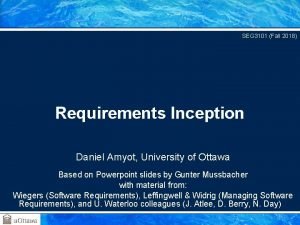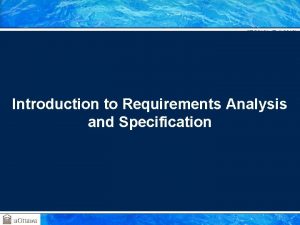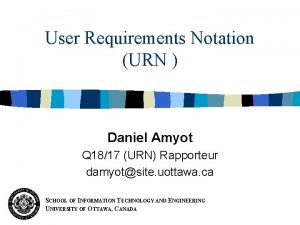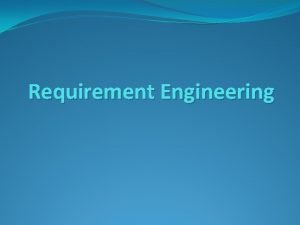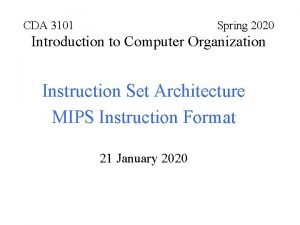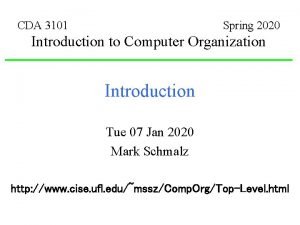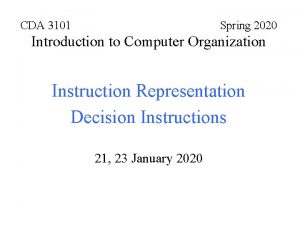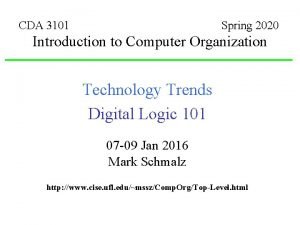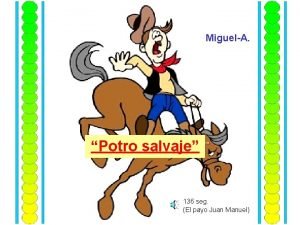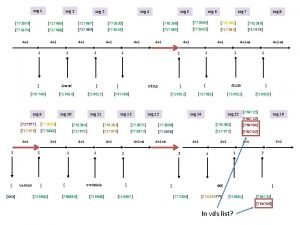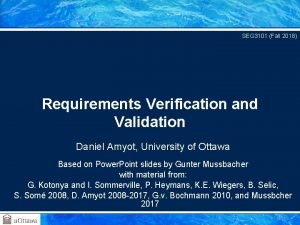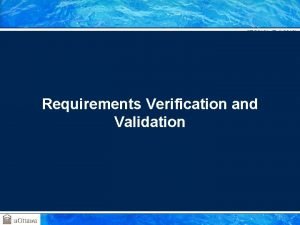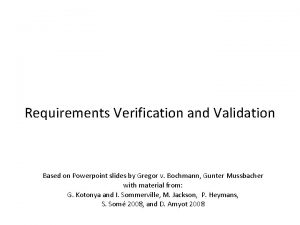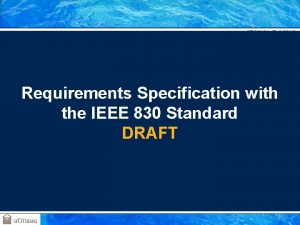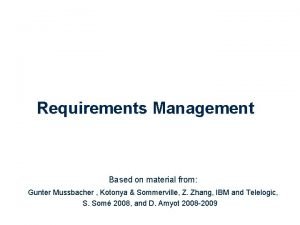SEG 3101 Fall 2018 Requirements Inception Daniel Amyot

















- Slides: 17

SEG 3101 (Fall 2018) Requirements Inception Daniel Amyot, University of Ottawa Based on Powerpoint slides by Gunter Mussbacher with material from: Wiegers (Software Requirements), Leffingwell & Widrig (Managing Software Requirements), and U. Waterloo colleagues (J. Atlee, D. Berry, N. Day)

Table of Contents • Problem Analysis • Business Requirements • Steps for Problem Analysis • Vision and Scope Document • Project Viability • … Content covered in more detail in other courses, but overviewed here as a starting point. • The important thing is not to stop questioning. Curiosity has its own reason for existing. 1 [1] Albert Einstein (1879 - 1955) SEG 3101 (Fall 2018). Requirements Inception. 2

Problem Analysis Business Requirements Agreement Root Causes Stakeholders Vision & Scope Constraints Document Problem Analysis • Goal: gain a better understanding of the problem being solved before development begins • Identify root cause • Identify stakeholders and their needs (or problems) • Identify solution boundary • Uses business requirements obtained from stakeholders • Results in Product Vision and Project Scope SEG 3101 (Fall 2018). Requirements Inception. 3

Problem Analysis Business Requirements Agreement Root Causes Stakeholders Vision & Scope Constraints Document Business Requirements / Objectives (1) • Business Opportunity • Description of market opportunity, competing market, business problem being solved or improved, advantage of proposed solution. . . • Example: Exploit the poor security record of a competing product • Business Objective and Success Criteria • Important business benefits the product will provide in a quantitative and measurable way, how success will be measured, factors that have great impact on success. . . • Examples: Achieve positive cash flow on the product within 6 months; Get 50%+ of the market • Business Risks • Major risks associated with developing or not developing the product (marketplace competition, timing, user acceptance, available resources, implementation issues. . . ) • Can be modeled with goals SEG 3101 (Fall 2018). Requirements Inception. 4

Problem Analysis Business Requirements Agreement Root Causes Stakeholders Vision & Scope Constraints Document Business Requirements (2) • Important for: • Ensuring that all project participants work for the same reasons • Getting stakeholders agreement on requirements • User and software requirements must align with the context and objective defined by business requirements • Requirements that do not help achieve business objectives should not be included SEG 3101 (Fall 2018). Requirements Inception. 5

Problem Analysis Business Requirements Agreement Root Causes Stakeholders Vision & Scope Constraints Document Problem Analysis – Understand Root Causes (1) • There is often a problem behind the problem • Root cause analysis consists of finding underlying causes that may not be immediately apparent • Determine recursively what factors contribute to the problem • Example: Our e commerce site is not profitable • Why is it not profitable? • Poor site design? • Bad pricing? • Poor customer management after the sale? • In what proportions? SEG 3101 (Fall 2018). Requirements Inception. 6

Problem Analysis Business Requirements Agreement Root Causes Stakeholders Vision & Scope Constraints Document Problem Analysis – Understand Root Causes (2) • Address Root Causes • Root causes do not all have same impact • Some may not be worth fixing, at least for now • Estimate relative impact of root causes (e. g. , with the help of a Pareto (bar) chart): 20% of causes 80% of problems… • Create problem statement for root cause problem identified as worth solving (and with computer solution) https: //www. 6 sigma. us/training/create pareto chart root cause analysis/ SEG 3101 (Fall 2018). Requirements Inception.

Problem Analysis Business Requirements Agreement Root Causes Stakeholders Vision & Scope Constraints Document “Low Hanging Fruits” SEG 3101 (Fall 2018). Requirements Inception. 8

Problem Analysis Business Requirements Agreement Root Causes Stakeholders Vision & Scope Constraints Document Problem Analysis – Product Vision and Project Scope • Product Vision: describes what the product is about and what it could eventually become • Aligns all stakeholders in a common direction • Project Scope: identifies what portion of the ultimate long term product vision the current project will address • Draws boundary between what is in and what is out Product Vision Project Scope for release 1. 0 Project Scope for release 1. 1 …. . Project Scope for release n SEG 3101 (Fall 2018). Requirements Inception. 9

Problem Analysis Business Requirements Agreement Root Causes Stakeholders Vision & Scope Constraints Document Vision Statement (1) • Vision Statement template for Products (according to Moore) • For [target customer] • Who [statement of the need or opportunity] • The [product name] • Is [a product category] • That [key benefit, compelling reason to buy or use] • Unlike [primary competitive alternative, current system, or current business process], • Our product [statement of primary differentiation and advantages of new product] SEG 3101 (Fall 2018). Requirements Inception. 10

Problem Analysis Business Requirements Agreement Root Causes Stakeholders Vision & Scope Constraints Document Vision Statement (2) • Example • For scientists who need to request containers of chemicals, the Chemical Tracking System is an information system that will provide a single point of access to the chemical stockroom and vendors. The system will store the location of every chemical container within the company, the quantity of material remaining in it and the complete history of each container's location and usage. This system will save the company 25% on chemical costs in the first year of use by allowing the company to fully exploit chemicals that are already available within the company, dispose of fewer partially used or expired containers and use a single standard chemical purchasing process. Unlike the current manual ordering processes, our product will generate all reports required to comply with government regulations that require the reporting of chemical usage, storage, and disposal. SEG 3101 (Fall 2018). Requirements Inception. 11

Problem Analysis Business Requirements Agreement Root Causes Stakeholders Vision & Scope Constraints Document Vision Statement (Enterprise Level) (3) • u. Ottawa Vision (2010) • We aspire to be, among universities, the essential reference on what Canada represents: a university that is an integral part of its community, open to the world, and distinguished by its search for excellence in research, its high quality learning environment, its passion for knowledge and innovation, its leadership on language issues, and its openness to diversity. Every member of our institution will take part in our educational mission. SEG 3101 (Fall 2018). Requirements Inception. 12

Problem Analysis Business Requirements Agreement Root Causes Stakeholders Vision & Scope Constraints Document Vision Statement (Enterprise Level) (4) • u. Ottawa Vision (Today) • The University of Ottawa will offer an unparalleled university experience and, through outstanding teaching and research, play a vital role in defining the world of tomorrow. We will instil in each of our graduates an ethic of service, a culture of engagement and an awareness of shared responsibility that will prepare them for global citizenship. • http: //www. uottawa. ca/about/sites/www. uottawa. ca. about/files/destinati on 2020 plan strategique. pdf • Vision at The Ottawa Hospital • To provide each patient with the world class care, exceptional service and compassion we would want for our loved ones. • http: //www. ottawahospital. on. ca/en/about us/our vision/ SEG 3101 (Fall 2018). Requirements Inception. 13

Problem Analysis Business Requirements Agreement Root Causes Stakeholders Vision & Scope Constraints Document Dynamic Vision, Scope and Requirements… • The product vision may apply to many projects • Views of the customer, of the enterprise • Evolves rather slowly (e. g. , in years) • The product scope focuses on one project • Important to the project manager • More dynamic than the vision • Can be part of a requirements document • Requirements focus on what is needed in order for the product to meet business objectives • Many and rapid changes! SEG 3101 (Fall 2018). Requirements Inception. 14

Problem Analysis Business Requirements Agreement Root Causes Stakeholders Vision & Scope Constraints Document Project Viability – Scope • Scope: product's purpose and the system's boundaries • How much of the work will be done by the system-to-be-developed? • How much of the work will be done by interacting systems? • Information needed for cost and time estimates • Define more precisely the problem to solve • List all the things the system should have to do • Exclude as much as possible to reduce the complexity of the problem • Establish broader goals if the problem is too simple • Example: an automated system for university registration Initial list of wide problems Course Browser Registration Payment Room Allocation Exam Schedule Reduced scope Course Browser Registration Payment For other systems Room Allocation Exam Schedule Later stage SEG 3101 (Fall 2018). Requirements Inception.

Problem Analysis Business Requirements Agreement Root Causes Stakeholders Vision & Scope Constraints Document Vision and Scope Document • Business requirements • Vision of the solution • Including major features and dependencies • Scope and limitation • For initial and subsequent releases • Business context • Including priorities and operating environment • Risks!!! SEG 3101 (Fall 2018). Requirements Inception. 16

Problem Analysis Business Requirements Agreement Root Causes Stakeholders Vision & Scope Constraints Document In Summary… “The idea is to do just enough investigation to form a rational, justifiable opinion of the overall purpose and feasibility of the potential new system, and decide if it is worthwhile to invest in deeper exploration” [Craig Larman] SEG 3101 (Fall 2018). Requirements Inception. 17


